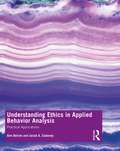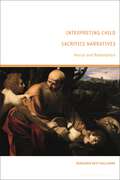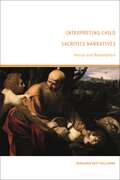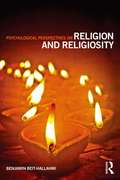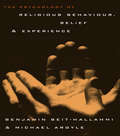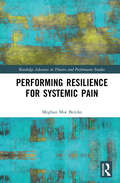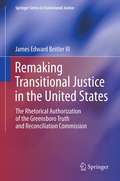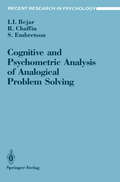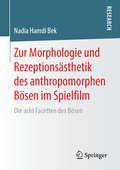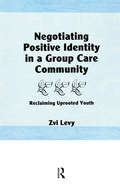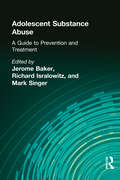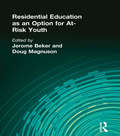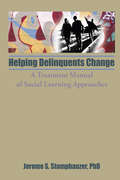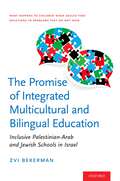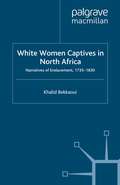- Table View
- List View
Understanding Ethics in Applied Behavior Analysis: Practical Applications
by Ann B. Beirne Jacob A. SadavoyDrawing upon combined 35 years of clinical experience as well as the reflections of colleagues in the field, Understanding Ethics in Applied Behavior Analysis provides the foundation for a lifelong journey of ethical practice in service for individuals with autism spectrum disorder (ASD) and other developmental disabilities. This book includes an explanation of each element in the Behavior Analyst Certification Board (BACB) Professional and Ethical Compliance Code for Behavior Analysts®, along with insightful examples, thought-provoking considerations, and contributions from experts in the field. This text also addresses professional behavior for the behavior analyst when fulfilling roles as teacher, employee, manager, colleague, advocate, or member of a multidisciplinary team.
Understanding Ethics in Applied Behavior Analysis: Practical Applications
by Ann Beirne Jacob A. SadavoyThis book provides the foundation for a lifelong journey of ethical practice in service for individuals with autism spectrum disorder and other developmental disabilities. The second edition of Understanding Ethics in Applied Behavior Analysis includes an explanation of each element in the Ethics Code for Behavior Analysts, along with considerations for ethical practice and examples from the field. Professional behavior for the behavior analyst is also addressed when fulfilling roles as teacher, employee, manager, colleague, advocate, or member of a multidisciplinary team. This new edition expands on the first chapter’s introduction of moral philosophy, adds a new chapter on ethical decision-making and core principles, and provides a study guide to assist those preparing for the Behavior Analyst Certification Board exams. Drawing upon Beirne and Sadavoy’s combined 40 years of clinical experience as well as the reflections of colleagues in the field, this is an indispensable guide to ethics for behavior analysis students.
Understanding Ethics in Applied Behavior Analysis: Practical Applications
by Ann Beirne Jacob A. SadavoyThis book provides the foundation for a lifelong journey of ethical practice in service for individuals with autism spectrum disorder and other developmental disabilities. The second edition of Understanding Ethics in Applied Behavior Analysis includes an explanation of each element in the Ethics Code for Behavior Analysts, along with considerations for ethical practice and examples from the field. Professional behavior for the behavior analyst is also addressed when fulfilling roles as teacher, employee, manager, colleague, advocate, or member of a multidisciplinary team. This new edition expands on the first chapter’s introduction of moral philosophy, adds a new chapter on ethical decision-making and core principles, and provides a study guide to assist those preparing for the Behavior Analyst Certification Board exams. Drawing upon Beirne and Sadavoy’s combined 40 years of clinical experience as well as the reflections of colleagues in the field, this is an indispensable guide to ethics for behavior analysis students.
Interpreting Child Sacrifice Narratives: Horror and Redemption
by Benjamin Beit-HallahmiExamining the theme of child sacrifice as a psychological challenge, this book applies a unique approach to religious ideas by looking at beliefs and practices that are considered deviant, but also make up part of mainstream religious discourse in Judaism, Islam, and Christianity. Ancient religious mythology, which survives through living traditions and transmitted narratives, rituals, and writings, is filled with violent stories, often involving the targeting of children as ritual victims. Christianity offers Abraham's sacrifice and assures us that the “only begotten son” has died, and then been resurrected. This version of the sacrifice myth has dominated the West. It is celebrated in an act of fantasy cannibalism, in which the believers share the divine son's flesh and blood. This book makes the connection between Satanism stories in the 1980s, the Blood Libel in Europe, The Eucharist, and Eastern Mediterranean narratives of child sacrifice.
Interpreting Child Sacrifice Narratives: Horror and Redemption
by Benjamin Beit-HallahmiExamining the theme of child sacrifice as a psychological challenge, this book applies a unique approach to religious ideas by looking at beliefs and practices that are considered deviant, but also make up part of mainstream religious discourse in Judaism, Islam, and Christianity. Ancient religious mythology, which survives through living traditions and transmitted narratives, rituals, and writings, is filled with violent stories, often involving the targeting of children as ritual victims. Christianity offers Abraham's sacrifice and assures us that the “only begotten son” has died, and then been resurrected. This version of the sacrifice myth has dominated the West. It is celebrated in an act of fantasy cannibalism, in which the believers share the divine son's flesh and blood. This book makes the connection between Satanism stories in the 1980s, the Blood Libel in Europe, The Eucharist, and Eastern Mediterranean narratives of child sacrifice.
Psychological Perspectives on Religion and Religiosity
by Benjamin Beit-HallahmiIs religion to blame for deadly conflicts? Should religious behaviour be credited more often for acts of charity and altruism? In what ways are religious and ‘spiritual’ ideas, practices and identities surviving and changing as religion loses its political power in those parts of the world which are experiencing increasing secularization? Written by one of the world’s leading authorities on the psychology of religion and social identity, Psychological Perspectives on Religion and Religiosity offers a comprehensive and multidisciplinary review of a century of research into the origins and consequences of religious belief systems and religious behaviour. The book employs a unique theoretical framework that combines the ‘new’ cognitive-evolutionary psychology of religion, examining the origins of religious ideas, with the ‘old’ psychology of religiosity, which looks at correlates and consequences. It examines a wide range of psychological variables and their relationship with religiosity. It is also provides fresh insights into classical topics in the psychology of religion, such as religious conversion, the relevance of Freud’s ideas about religion and religiosity, the meaning of secularization, and the crucial role women play in religion. The book concludes with the author’s reflections on the future for the psychology of religion as a field. Psychological Perspectives on Religion and Religiosity will be invaluable for academic researchers in psychology, sociology, anthropology, political science, economics, and history worldwide. It will also be of great interest to advanced undergraduate students and graduate students across the social sciences.
Psychological Perspectives on Religion and Religiosity
by Benjamin Beit-HallahmiIs religion to blame for deadly conflicts? Should religious behaviour be credited more often for acts of charity and altruism? In what ways are religious and ‘spiritual’ ideas, practices and identities surviving and changing as religion loses its political power in those parts of the world which are experiencing increasing secularization? Written by one of the world’s leading authorities on the psychology of religion and social identity, Psychological Perspectives on Religion and Religiosity offers a comprehensive and multidisciplinary review of a century of research into the origins and consequences of religious belief systems and religious behaviour. The book employs a unique theoretical framework that combines the ‘new’ cognitive-evolutionary psychology of religion, examining the origins of religious ideas, with the ‘old’ psychology of religiosity, which looks at correlates and consequences. It examines a wide range of psychological variables and their relationship with religiosity. It is also provides fresh insights into classical topics in the psychology of religion, such as religious conversion, the relevance of Freud’s ideas about religion and religiosity, the meaning of secularization, and the crucial role women play in religion. The book concludes with the author’s reflections on the future for the psychology of religion as a field. Psychological Perspectives on Religion and Religiosity will be invaluable for academic researchers in psychology, sociology, anthropology, political science, economics, and history worldwide. It will also be of great interest to advanced undergraduate students and graduate students across the social sciences.
The Psychology of Religious Behaviour, Belief and Experience
by Benjamin Beit-Hallahmi Michael ArgyleBecause society is increasingly secular, it may seem irrelevant to consider the psychology of religion. But the diversity of our multi-ethnic and multi-cultural society in fact makes religion more important to the social sciences than it has ever been before. What are the social consequences of religion? Every day the news is full of events that can be blamed on religion perpetrated by a range of groups from whole societies to individuals. Beit-Hallami and Argyle are renowned for their clear, analytical approach to topics and this new, state-of-the-art study of psychology and religion is no exception. It will be welcomed as an update to their previous work in the area by social psychologists, sociologists and theologians worldwide.
The Psychology of Religious Behaviour, Belief and Experience
by Benjamin Beit-Hallahmi Michael ArgyleBecause society is increasingly secular, it may seem irrelevant to consider the psychology of religion. But the diversity of our multi-ethnic and multi-cultural society in fact makes religion more important to the social sciences than it has ever been before. What are the social consequences of religion? Every day the news is full of events that can be blamed on religion perpetrated by a range of groups from whole societies to individuals. Beit-Hallami and Argyle are renowned for their clear, analytical approach to topics and this new, state-of-the-art study of psychology and religion is no exception. It will be welcomed as an update to their previous work in the area by social psychologists, sociologists and theologians worldwide.
Performing Resilience for Systemic Pain (Routledge Advances in Theatre & Performance Studies)
by Meghan Moe BeitiksHow might performance serve as a means for facing ubiquitous trauma and pain, in humans and ecologies? While reflecting on her multidisciplinary work Systems of Pain/Networks of Resilience, artist Meghan Moe Beitiks considers bodies of knowledge in Trauma Theory, Intersectional Feminist Philosophy, Ecology, Disability Studies, New Materialism, Object-Oriented Ontology, Gender Studies, Artistic Research, Psychology, Performance Studies, Social Justice, Performance Philosophy, Performance Art, and a series of first-person interviews in an attempt to answer that question. Beitiks brings us through the first-person process of making the work and the real-life, embodied encounters with the theories explored within it as an expansion of the work itself. Facing down difficult issues like trauma, discrimination, and the vulnerability of the body, Beitiks looks to commonalities across species and disciplines as means of developing resilience and cultivating communities. Rather than paint a picture of glorious potential utopias, Beitiks takes a hard look at herself as an embodiment of the values explored in the work, and stays with the difficult, sucky, troubling, work to be done. Performing Resilience for Systemic Pain is a vulnerable book about the quiet presence and hard looking needed to shift systems away from their oppressive, destructive realities.
Performing Resilience for Systemic Pain (Routledge Advances in Theatre & Performance Studies)
by Meghan Moe BeitiksHow might performance serve as a means for facing ubiquitous trauma and pain, in humans and ecologies? While reflecting on her multidisciplinary work Systems of Pain/Networks of Resilience, artist Meghan Moe Beitiks considers bodies of knowledge in Trauma Theory, Intersectional Feminist Philosophy, Ecology, Disability Studies, New Materialism, Object-Oriented Ontology, Gender Studies, Artistic Research, Psychology, Performance Studies, Social Justice, Performance Philosophy, Performance Art, and a series of first-person interviews in an attempt to answer that question. Beitiks brings us through the first-person process of making the work and the real-life, embodied encounters with the theories explored within it as an expansion of the work itself. Facing down difficult issues like trauma, discrimination, and the vulnerability of the body, Beitiks looks to commonalities across species and disciplines as means of developing resilience and cultivating communities. Rather than paint a picture of glorious potential utopias, Beitiks takes a hard look at herself as an embodiment of the values explored in the work, and stays with the difficult, sucky, troubling, work to be done. Performing Resilience for Systemic Pain is a vulnerable book about the quiet presence and hard looking needed to shift systems away from their oppressive, destructive realities.
Remaking Transitional Justice in the United States: The Rhetorical Authorization of the Greensboro Truth and Reconciliation Commission (Springer Series in Transitional Justice)
by James Edward Beitler IIIRemaking Transitional Justice in the United States: The Rhetoric of the Greensboro Truth and Reconciliation Commission explores rhetorical attempts to authorize the Greensboro Truth and Reconciliation Commission—a grassroots, U.S.-based truth commission created in 2004 toredress past injustices in the city. Through detailed rhetorical analyses, the book demonstratesthat the development of the field of transitional justice has given rise to a transnational rhetorical tradition that provides those working in the field with series of “enabling constraints.” The book then shows how Greensboro stakeholders attempted to reaccentuate this rhetorical tradition in their rhetorical performances to construct authority and bring about justice, even as the tradition shaped their discourse in ways that limited the scope of their responses. Calling attention to the rhetorical interdependence among practitioners of transitional justice, this study offers insights into the development of transitional justice in the United States and in grassroots contexts in other liberal democracies. The volume is a relevant guide to scholars and practitioners of transitional justice as it brings into relief mechanisms of transitional justice that are frequently overlooked—namely, rhetorical mechanisms. It also speaks to any readers who may be interested in the communicative strategies/tactics that may be employed by grassroots transitional justice initiatives.
Cognitive and Psychometric Analysis of Analogical Problem Solving (Recent Research in Psychology)
by Isaac I. Bejar Roger Chaffin Susan EmbretsonIf one were to conduct an analysis of any profession the "ability to think analogically" is more than likely to be one of the requirements for success, be it an architectural studio, a research laboratory, a legal office, or a nuclear plant. Cognitive scientists are aware of the prominence of analogical reasoning in all forms of reasoning and learning, and have devoted substantial effort to ascer taining its nature. Test builders, like cognitive scientists, are aware of the cen trality of analogical reasoning and figure, correctly, that a test that samples a student's ability to think analogically may well be a good predictor of success in a variety of fields. This book is the result of a project to investigate analogical reasoning from both an individual differences and a cognitive perspective. The book is directed to both researchers and practitioners concerned with the nature and measurement of analogical reasoning. Cognitive scientists, linguists, psycholinguists, and natural language researchers will find the seman tic taxonomy and accompanying empirical results food for thought. Test devel opers will fmd it reassuring that performance on verbal analogy items is not just a reflection of the size of a person's vocabulary, and that tests can be designed according to principles, rather than assembled to satisfy a set of statistical speci fications. Psychometricians will find that content and response modelling can go together and that there are distinct benefits in approaching psychometric re sponse modelling from that integrative perspective.
Zur Morphologie und Rezeptionsästhetik des anthropomorphen Bösen im Spielfilm: Die acht Facetten des Bösen
by Nadia Hamdi BekNadia Hamdi Bek befasst sich mit dem scheinbaren Paradox, dass amoralische Charaktere im Spielfilm auch positiv wirken und Faszination auslösen können. Im Fokus stehen dabei die Rekonstruktion der psychologischen Mechanismen bei ihrer Wahrnehmung und Beurteilung durch den Rezipienten sowie die Binnendifferenzierung ihrer Amoral. Im Gegensatz zu herkömmlichen Herangehensweisen zur Erforschung der Rezeptionsästhetik amoralischer Filmfiguren verbindet die Autorin geisteswissenschaftlich orientierte Theorien des Films und der Ästhetik mit der für die Psychologie typischen, dezidiert quantitativen, empirischen Forschungsmethodik.
Negotiating Positive Identity in a Group Care Community: Reclaiming Uprooted Youth
by Jerome BekerIn this readable book, Zvi Levy, Hadassim’s Director, provides a careful account of how, over time, he and others have shaped a community to foster health, identity, and competence in distressed young people. Canadian WIZO (Women’s International Zionist Organization) Hadassim is a thriving youth village in Israel that is home for 500 young people and a day educational program for an additional 1,000. Negotiating Positive Identity in a Residential Group Care Community illustrates the organizational expression of a developmental idea, in this case Erik Erikson’s identity development theory, to show how an environment can be created to cope with disrupted development processes among children and adolescents. The book describes an ongoing experiment that started fifteen years ago and has since been recognized as an outstanding success. The basic information and ideas expressed by Levy can be used to improve the effectiveness of any framework through which adolescents pass during the stages of development, including schools, community centers, and normal families. Some of the main topics discussed in this volume are: principles for running a multicultural facility organization of the daily life of a large residential setting major parameters in a residential setting as derived from the theories of Erik Erikson on adolescence as a developmental stage comprehensive care for youth in transition and adolescents suffering from aggravated identity crisesAll child and youth care workers and program administrators can learn much from Levy’s account of Hadassim. Negotiating Positive Identity in a Residential Group Care Community will be disturbing to many who adhere to the current tenets of good management and child care practice; readers need to be prepared to have many assumptions and beliefs challenged. The book emphasizes the distress of immigrant and troubled urban youth as an aggravated identity crisis, the cause of which needs to be treated before the symptom. This volume is of interest to theoreticians, practitioners, and policymakers in the fields of education, child and youth care, and developmental psychology, as well as scholars in Erikson’s theories. It is also useful in courses which study education in Israel or that seek solutions to problems such as homeless youth in the Third World.Negotiating Positive Identity in a Residential Group Care Community stresses that: The answer to deprivation is not the provision of efficient services, but an environment and an approach that encourages adolescents to see themselves as active participants and not as patients or passive inmates. Residential settings for children and adolescents can successfully handle large numbers and, in fact, larger numbers can offer some definite advantages. The best way to help children develop into autonomous adults is to give them responsibility for their own choices within the framework of a goal-oriented community.
Negotiating Positive Identity in a Group Care Community: Reclaiming Uprooted Youth
by Jerome BekerIn this readable book, Zvi Levy, Hadassim’s Director, provides a careful account of how, over time, he and others have shaped a community to foster health, identity, and competence in distressed young people. Canadian WIZO (Women’s International Zionist Organization) Hadassim is a thriving youth village in Israel that is home for 500 young people and a day educational program for an additional 1,000. Negotiating Positive Identity in a Residential Group Care Community illustrates the organizational expression of a developmental idea, in this case Erik Erikson’s identity development theory, to show how an environment can be created to cope with disrupted development processes among children and adolescents. The book describes an ongoing experiment that started fifteen years ago and has since been recognized as an outstanding success. The basic information and ideas expressed by Levy can be used to improve the effectiveness of any framework through which adolescents pass during the stages of development, including schools, community centers, and normal families. Some of the main topics discussed in this volume are: principles for running a multicultural facility organization of the daily life of a large residential setting major parameters in a residential setting as derived from the theories of Erik Erikson on adolescence as a developmental stage comprehensive care for youth in transition and adolescents suffering from aggravated identity crisesAll child and youth care workers and program administrators can learn much from Levy’s account of Hadassim. Negotiating Positive Identity in a Residential Group Care Community will be disturbing to many who adhere to the current tenets of good management and child care practice; readers need to be prepared to have many assumptions and beliefs challenged. The book emphasizes the distress of immigrant and troubled urban youth as an aggravated identity crisis, the cause of which needs to be treated before the symptom. This volume is of interest to theoreticians, practitioners, and policymakers in the fields of education, child and youth care, and developmental psychology, as well as scholars in Erikson’s theories. It is also useful in courses which study education in Israel or that seek solutions to problems such as homeless youth in the Third World.Negotiating Positive Identity in a Residential Group Care Community stresses that: The answer to deprivation is not the provision of efficient services, but an environment and an approach that encourages adolescents to see themselves as active participants and not as patients or passive inmates. Residential settings for children and adolescents can successfully handle large numbers and, in fact, larger numbers can offer some definite advantages. The best way to help children develop into autonomous adults is to give them responsibility for their own choices within the framework of a goal-oriented community.
Adolescent Substance Abuse: A Guide to Prevention and Treatment
by Jerome Beker Richard Isralowitz Mark SingerAn enlightening discussion of the major issues related to the prevention and treatment of adolescent substance abuse. Information-packed chapters lend a new perspective to the field and suggest implications for practice in services for youth.
Adolescent Substance Abuse: A Guide to Prevention and Treatment
by Jerome Beker Richard Isralowitz Mark SingerAn enlightening discussion of the major issues related to the prevention and treatment of adolescent substance abuse. Information-packed chapters lend a new perspective to the field and suggest implications for practice in services for youth.
Residential Education as an Option for At-Risk Youth
by Jerome Beker Doug MagnusonResidential Education as an Option for At-Risk Youth explores recent residential programs in Israel, draws comparisons with their European counterparts, and recommends practical approaches for the revitalization of such programs in the United States. This volume refutes the conventional professional “wisdom” in the United States that residential group care programs for children and youth are intrinsically flawed and counterproductive. Instead, it delivers effective models for the implementation of effective residential services. The editors and authors demonstrate the growing need for residential programs, given the overburdened family foster care resources, swelling numbers of “zero-parent” families, and homeless youth. Though the United States helped launch and develop residential services in Europe in the aftermath of World War II and has produced many excellent thinkers in the domain of quality residential group care, American programs have languished in recent decades. This book is designed to accelerate and facilitate progress in revamping and establishing excellent residential group care. The authors examine residential education as a developmentally based alternative to the more clinically and correctionally oriented programs for marginal children and youth dominating this field in the United States.The authors present their material in the context of appropriate theoretical principles, yet in practical ways that will permit program developers and managers to implement it effectively. Some of the specific areas chapters discuss are: exemplary Israeli programs as observed by visiting American professional in social work and allied fields important program variables and the cultural influences that may affect them African American experience for such programs a conceptual model for building successful residential education programs key organizational and management considerationsResidential Education as an Option for At-Risk Youth serves as a vital resource for ambitious program developers and managers wishing to reconceptualize and enrich their programs. It will also benefit advanced students, practitioners, and decision makers who have had, heretofore, few resources to rely on when seeking to promote more effective programs for socially marginal children and youth.
Residential Education as an Option for At-Risk Youth
by Jerome Beker Doug MagnusonResidential Education as an Option for At-Risk Youth explores recent residential programs in Israel, draws comparisons with their European counterparts, and recommends practical approaches for the revitalization of such programs in the United States. This volume refutes the conventional professional “wisdom” in the United States that residential group care programs for children and youth are intrinsically flawed and counterproductive. Instead, it delivers effective models for the implementation of effective residential services. The editors and authors demonstrate the growing need for residential programs, given the overburdened family foster care resources, swelling numbers of “zero-parent” families, and homeless youth. Though the United States helped launch and develop residential services in Europe in the aftermath of World War II and has produced many excellent thinkers in the domain of quality residential group care, American programs have languished in recent decades. This book is designed to accelerate and facilitate progress in revamping and establishing excellent residential group care. The authors examine residential education as a developmentally based alternative to the more clinically and correctionally oriented programs for marginal children and youth dominating this field in the United States.The authors present their material in the context of appropriate theoretical principles, yet in practical ways that will permit program developers and managers to implement it effectively. Some of the specific areas chapters discuss are: exemplary Israeli programs as observed by visiting American professional in social work and allied fields important program variables and the cultural influences that may affect them African American experience for such programs a conceptual model for building successful residential education programs key organizational and management considerationsResidential Education as an Option for At-Risk Youth serves as a vital resource for ambitious program developers and managers wishing to reconceptualize and enrich their programs. It will also benefit advanced students, practitioners, and decision makers who have had, heretofore, few resources to rely on when seeking to promote more effective programs for socially marginal children and youth.
Helping Delinquents Change: A Treatment Manual of Social Learning Approaches
by Jerome Beker Jerome StumphauzerHelping Delinquents Change sets before itself a formidable task--that of removing the mystery from the understanding of delinquent behavior. Jerome Stumphauzer offers direct, useful means to work toward altering delinquent behavior. Abandoning an orientation to delinquency that focuses on punishment or medical models, Stumphauzer presents a view of delinquency that emphasizes the learning of adaptive, prosocial behavior, and provides to the youths themselves an opportunity to become engaged in selecting their own goals and methods for changing their behavior. The nondelinquent is presented as an example from whom to learn. The text is nontechnical and useful for students and practitioners alike. The book in intended expressly for those who work directly with delinquents--counselors, teachers, therapists, probation officers, those working in junvenile corrections, and for students of delinquent behavior in psychology, sociology, criminology, and education. Tables, diagrams, references, and indices supplement the text. Helping Delinquents Change is available for classroom adoption. Undergraduate and graduate students in criminology, psychology, counseling, education, and sociology are the primary audience. The book is particularly well-suited as a training manual or supplementary text and an instructor&’s manual is included.
Helping Delinquents Change: A Treatment Manual of Social Learning Approaches
by Jerome Beker Jerome StumphauzerHelping Delinquents Change sets before itself a formidable task--that of removing the mystery from the understanding of delinquent behavior. Jerome Stumphauzer offers direct, useful means to work toward altering delinquent behavior. Abandoning an orientation to delinquency that focuses on punishment or medical models, Stumphauzer presents a view of delinquency that emphasizes the learning of adaptive, prosocial behavior, and provides to the youths themselves an opportunity to become engaged in selecting their own goals and methods for changing their behavior. The nondelinquent is presented as an example from whom to learn. The text is nontechnical and useful for students and practitioners alike. The book in intended expressly for those who work directly with delinquents--counselors, teachers, therapists, probation officers, those working in junvenile corrections, and for students of delinquent behavior in psychology, sociology, criminology, and education. Tables, diagrams, references, and indices supplement the text. Helping Delinquents Change is available for classroom adoption. Undergraduate and graduate students in criminology, psychology, counseling, education, and sociology are the primary audience. The book is particularly well-suited as a training manual or supplementary text and an instructor&’s manual is included.
The Promise of Integrated Multicultural and Bilingual Education: Inclusive Palestinian-Arab and Jewish Schools in Israel
by Zvi BekermanThe Promise of Integrated and Multicultural Bilingual Education presents the results of a long-term ethnographic study of the integrated bilingual Palestinian-Jewish schools in Israel that offer a new educational option to two groups of Israelis--Palestinians and Jews--who have been in conflict for the last one hundred years. Their goal is to create egalitarian bilingual multicultural environments to facilitate the growth of youth who can acknowledge and respect "others" while maintaining loyalty to their respective cultural traditions. In this book, Bekerman reveals the complex school practices implemented while negotiating identity and culture in contexts of enduring conflict. Data gathered from interviews with teachers, students, parents, and state officials are presented and analyzed to explore the potential and limitations of peace education given the cultural resources, ethnic-religious affiliations, political beliefs, and historical narratives of the various interactants. The book concludes with critique of Western positivist paradigmatic perspectives that currently guide peace education, maintaining that one of the primary weaknesses of current bilingual and multicultural approaches to peace education is their failure to account for the primacy of the political framework of the nation state and the psychologized educational perspectives that guide their educational work. Change, it is argued, will only occur after these perspectives are abandoned, which entails critically reviewing present understandings of the individual, of identity and culture, and of the learning process.
The Promise of Integrated Multicultural and Bilingual Education: Inclusive Palestinian-Arab and Jewish Schools in Israel
by Zvi BekermanThe Promise of Integrated and Multicultural Bilingual Education presents the results of a long-term ethnographic study of the integrated bilingual Palestinian-Jewish schools in Israel that offer a new educational option to two groups of Israelis--Palestinians and Jews--who have been in conflict for the last one hundred years. Their goal is to create egalitarian bilingual multicultural environments to facilitate the growth of youth who can acknowledge and respect "others" while maintaining loyalty to their respective cultural traditions. In this book, Bekerman reveals the complex school practices implemented while negotiating identity and culture in contexts of enduring conflict. Data gathered from interviews with teachers, students, parents, and state officials are presented and analyzed to explore the potential and limitations of peace education given the cultural resources, ethnic-religious affiliations, political beliefs, and historical narratives of the various interactants. The book concludes with critique of Western positivist paradigmatic perspectives that currently guide peace education, maintaining that one of the primary weaknesses of current bilingual and multicultural approaches to peace education is their failure to account for the primacy of the political framework of the nation state and the psychologized educational perspectives that guide their educational work. Change, it is argued, will only occur after these perspectives are abandoned, which entails critically reviewing present understandings of the individual, of identity and culture, and of the learning process.
White Women Captives in North Africa: Narratives of Enslavement, 1735-1830
by K. BekkaouiA fascinating anthology of narratives from the period 1735-1830, by European women who recount their enslavement in North Africa. The first such collection, it includes an extensive introduction which links the discourse on contemporary Western women captives in Iran, Afghanistan and Iraq with that of former white captives in North Africa.
